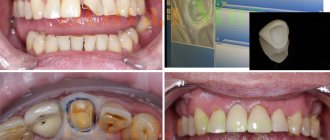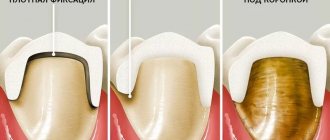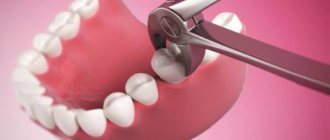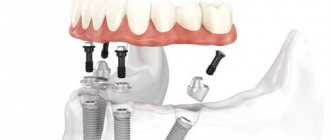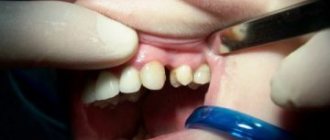The main causes of crown loss
A crown can fall out for several reasons:
- Weakening of the cement on which the crown rests, that is, its resorption.
- Erasure of the crown part or its breakage.
- Excessive pressure on the crown.
- Using temporary material to install a crown.
- The appearance of caries under the structure.
- Errors in grinding a tooth or making a crown.
Only a specialist can determine the exact cause of the crown and pin falling out. But anyone can be to blame: a technician, an orthopedic doctor, or the patient himself.
The dentist’s task is to qualitatively prepare the tooth for prosthetics and fix the crown using good material. When making a crown, the dental technician must also adhere to all the rules for its creation. The patient must follow all the doctor’s recommendations: follow the rules of hygiene and care of the crown, do not put pressure on it, and do not chew hard food in the crown area.
Emergency help
If a crown falls off on a tooth with a pin in the canal, then the question of going to the doctor should not even arise, because only a specialist can fix the problem. But there are situations when it is not possible to visit the dentist’s office in the near future. This can happen if a person is on vacation or a business trip. It will be technically impossible to return the structure to its place in the absence of the necessary skills and knowledge.
Therefore, at this time it is important not to damage the supporting tooth, since it is ground and most vulnerable to external influences. You need to treat him with care, do not put pressure on him, try not to drink or eat anything cold or hot. That is, to provide him with peace before going to the dentist.
What to do if it is not possible to see a doctor immediately
- Apply clove oil to the tooth and the pain will decrease.
- Wash the crown and install it on the tooth using cement, which is sold in the pharmacy chain. It is not advisable to do this, but if you contact your dentist and get the go-ahead, you can fix the product temporarily, according to the recommendations of a specialist. You should first rinse your mouth with an antiseptic.
- If necessary, you can take painkillers.
- If the crown falls off and cannot be found, you can simply lubricate the tooth with pharmaceutical cement - this technique will somewhat reduce the discomfort.
What you should absolutely not do if your dental crown has fallen out
Do not try to replace the fallen crown; nothing will come of this venture anyway. In addition, the following actions are strictly prohibited:
- Do not attempt to glue a crown to a tooth; remember that any adhesive that is not dental-related can be toxic.
- Any attempt to glue the prosthesis will still end in failure.
- If you try to put the structure back in place on your own, you can damage both the prosthesis itself and the supporting tooth or pin.
Never use regular cement, glue or chewing gum!
The fallen crown should be washed and dried thoroughly. Then try to return it to its place; with gentle pressure, the structure should sit in place. This will allow it to stay in place for a couple of days until the person goes to the dentist.
Ideally, you should promptly consult a doctor so that he can install a temporary crown made of plastic or compost while the prosthesis is repaired or a new one is made. This will protect the exposed ground tooth or dental post.
What affects the strength of cement
Installing a crown helps protect the tooth from wear and tear; this device is used to strengthen the dentition. If the crowns begin to become loose, certain factors may influence this. When installing a crown, it is necessary to comply with certain requirements for the shape of the stump on which the product is attached. The height of the dental inlay should be at least four millimeters, the taper should be no more than eight degrees, and the thickness of the volume of tissue for grinding should not be more than one and a half millimeters.
The listed factors regarding the shape of the stump insert directly affect the strength of the product. If any requirements are violated during installation, it can lead to the tooth under the crown starting to hurt, become inflamed, and subsequently the crown on the tooth becomes loose and becomes uncemented. Another factor that influences the fact that a tooth becomes loose can be the shape of the gingival ledge. If it is correct, the gums will not subsequently become inflamed and gradually collapse. If the crown is installed, but the gingival ledge is incorrect, this risks the gums becoming constantly inflamed and chronic local periodontitis beginning.
Another factor that can influence the appearance of a wobbly device is the structure of the stump tissue after turning for the structure:
- During preparation, it is important to try to preserve the structure of living tissue. This can be achieved if the tooth canals are not filled.
- During the preparation process, ample water cooling is important. In the absence of this factor, the tissues may overheat, their hardness and elasticity deteriorate, and as a result, this may cause the crowns to become loose. They can only be restored through complete replacement. To do this, the device is removed from the pin and replaced in compliance with all necessary requirements.
It is important that the higher the quality of the tooth tissue, the stronger the adhesive properties of dental cement will be.
What else affects an artificial loose tooth:
- for successful prosthetics, it is necessary to take into account all the rules of occlusion of the patient, as well as the characteristics of his bite, the condition of the gums and bone tissue;
- Local restoration of the dentition is not recommended. It is important to begin with a complete rehabilitation of the dental system.
Why does cementation occur?
When installing a crown, the supragingival part of the tooth is covered with a created cap. Such a device can be attached to a pin, or the base for attachment can be an inlay or your own tooth. Sometimes a condition occurs that the structure has left the stump. This happens due to certain reasons.
When using low-quality materials, the fixation is fragile, the device may not be installed tightly, and the cement used only fills a thin layer between the natural tooth and the device. If a metal-ceramic crown becomes uncemented, this is due to the fact that the structure was not made correctly. Mobility due to cement occurs only when the cement is too thick or too thin.
Sometimes an artificial tooth becomes loose due to an incorrect bite. A specialist must take this indicator into account in order to further prevent cracks and chips of reinforcing products. Motility occurs due to food particles getting under the cap. This happens due to an incorrectly prepared ledge and a loose fit of the device to the gum.
The shape of the inner surface of the product should be similar to the surface of your own tooth. This will ensure a tight fit and long service life of the device. If the fit is not tight, the structure will be removed after a short period of time. It can be summarized that the main reasons for de-cementing can be:
- Inaccuracy of the manufactured product, incorrectly selected shape.
- Stump height too low.
- Large preparation angle.
- Malocclusion.
- Failure to comply with cement mixing proportions and poor quality.
Inaccurate crown manufacturing
Dental technicians make dental crowns. At the initial stage, an impression is made of the patient’s jaw and a plaster model is built. The doctor cuts out the required tooth from the model and forms a wax mold. After hardening on the base, the element is placed in the oven for 4-6 hours. After burning out, the liquid alloy is poured into the heated mold.
This is interesting: How to install a crown on a tooth: nuances of preparation, stages
An error at any of the manufacturing stages can cause complications. If the required tightness is not observed, food debris will penetrate under the crown, which is a beneficial bacterial flora, ensuring a favorable course of bacterial proliferation in the oral cavity.
The danger for the patient is not only premature loosening. If these symptoms are ignored, the rotting process may start.
Low pulp height
To maintain the necessary vital activity of the pulp during preparation, it is recommended to leave a minimal layer of dentin. The thickness is determined on an individual basis after considering the patient's age and dental condition. It is worth remembering that difficulties and mistakes are often made at this stage, because even an x-ray allows one to obtain only approximate data on the condition of the pulp chamber.
Large preparation angle
The doctor must determine the minimum acceptable preparation angle that ensures full adhesion of the tooth and crown. At this stage, the main goal is to preserve the tissues of the periodontal sulcus. When creating a ledge, gum retraction is performed.
Malocclusion
An incorrect bite causes uneven distribution of chewing loads across the entire dentition. Dental tissues are constantly under stress, as a result of which they become thinner. In some cases, such pathology is considered a contraindication to prosthetics.
The decision on the possibility of carrying out manipulation is made by the attending physician on an individual basis. The patient must remember that malocclusion requires longer and more careful work by the orthodontist.
Failure to comply with cement proportions
A common cause of increased structural instability is a mistake by a specialist or his assistant. As with filling, a special solution is used for installation, which is mixed immediately before use.
The reason for the active looseness of the crown often lies in non-compliance with basic technologies, for example, violation of the proportions of cement mixing. The solution under such conditions is not able to fully perform its functions, which causes premature loosening.
What will happen at the dentist's appointment?
If a crown with a pin falls out, what should you do at the doctor’s appointment? The specialist initially assesses the condition of the broken crown, dental stump or pin. If necessary, an x-ray is taken. Provided the crown is intact and there are no other damages, the doctor can immediately fix the prosthesis.
If there is damage, preliminary treatment and the manufacture of a new structure will be required.
Here are the problems a dentist can solve if a crown with a pin falls out:
- Inserting the fallen crown into place. To do this, first remove the remaining fixative and treat the area with an antiseptic. Then the tooth or dental post is prepared.
- If there is a tooth under the crown, it is prepared again. If necessary, it is treated, the canals are cleaned, and its foundation is restored using fixing structures. After this, an impression is taken. And after 7-10 days you will be able to come and try on a new crown.
- If the root of the stump is destroyed, it is removed. If this is not done, the sore spot will become a source of infection. A bridge or implant is installed in place of the extracted tooth.
If little time has passed since the first visit to the dentist, that is, the warranty period has not expired, then all subsequent procedures are carried out completely free of charge. Otherwise, the doctor will have to pay for the work.
What is the procedure if the crown comes off a tooth?
The problem can be resolved by visiting a dentist; you should make an appointment with him in the near future. The main thing to do before visiting a doctor:
- Save the prosthesis.
- Take care of the safety of the supporting unit: since the ground tooth is weakened, you should not chew on the problem side;
- Minimize the load on the area with the fallen structure;
- Carefully remove food particles from the dental stump and periodically rinse your mouth with an antiseptic solution.
If a temporary crown comes off, you should call the clinic, explain the situation and make an appointment. You should not hesitate with this issue, so as not to provoke gum influx. Then the permanent crown may not fit correctly.
If the crown has fallen off the implant, do not delay visiting the doctor. If the fixation is made using a screw connection and it is enough to simply fix it again.
Why is it important to see your specialist?
You shouldn’t blame everything on a specialist if the crown and the pin fall off. Perhaps this is not the doctor's fault. In addition, it is advisable to make a second appointment with the same dentist, since he made a note in his journal or patient’s chart about how the prosthetics were carried out, what material was used and what problems were solved.
Sometimes dentists use conditionally temporary cements to establish bridges, which last on average from 1 to 2 years. Don’t think that the doctor saved money on you. This need arises to monitor the condition of the crown, its stability, and to clean the gums using special tools.
If the crown with temporary cement becomes loose
When using temporary cement and loosening the crown, a person may notice an unpleasant odor from under the structure. There is no need to try to glue the prosthesis on your own, as this can be fraught with the following consequences:
- It is possible to install the prosthesis on the wrong side and cause it to shift. As a result, when the teeth are closed, there is a danger of deformation or breakage of the structure.
- The crown may not fit properly enough, leading to chipping and difficulty chewing food. The gums underneath the denture may become damaged, causing pain in the area.
- As the crown loosens, it begins to affect the gum, which increases in size. After the doctor installs the prosthesis, the swollen gums will begin to interfere with it, and this will lead to subsequent problems with the crown, its loosening or the development of an inflammatory process.
- Bonding a crown is impossible at home and for the reason that special preparation is required. First, you need to clean its inner surface from residual cement. Then degrease, and only then place the prosthesis on a new fixing base. Such manipulations can only be done in the dentist’s office.
Is it possible to glue the bridge in place yourself?
What to do and how to secure a dental bridge if it falls out at home? Let us immediately point out that putting a fallen bridge back on your own is not the best idea. Since this can injure the supporting and neighboring teeth, harm the gums (if you suddenly decide to glue the bridge with pharmaceutical cement or household glue). The consequences can be unpredictable - up to the removal of “damaged” teeth or implants. Therefore, it is better to entrust your teeth to a professional dentist.
How to extend the life of crowns
To minimize the risk of crowns breaking and falling out, you must adhere to the following rules:
- Selection of quality material.
- The installation must be correct. To do this, you need to make sure that the structure is tightly attached to the base, that is, to the pin, supporting teeth and gums. If even tiny gaps are present, this will allow food to penetrate under the crown, which will lead to an inflammatory process.
- Compliance with the rules of care for crowns, only then will they last a long time. This includes maintaining oral hygiene, timely treatment of gum inflammation and caries.
Regular preventative examinations at the dentist will also be useful. This way, the specialist will be able to detect damage to the crown at an early stage, which will allow problems to be corrected in a timely and painless manner and to prevent the development of complications.
Prevention
Additional preventative measures to keep the crown in place include:
- High-quality and regular cleaning of teeth, gums, and the crown itself. It is advisable to use properly selected hygiene products.
- To completely get rid of food particles stuck between your teeth, you need to use dental floss.
- Do not put too much pressure on metal-ceramic structures.
- Don't indulge in too much solid food.
- Periodically have your teeth professionally cleaned in a dental office.
The crown fell out with the pin
If the crown and pin fall out, what should you do? There may also be several reasons for this situation:
- The special anatomical structure of the root.
- Fragile root structure.
- Poor passage of the canal during therapy. In this case, the pin tab is not installed over the entire length of the root, which causes poor installation of the crown.
- Cementation of the pin.
- If the patient has a history of pathologies such as periodontal disease, thin root walls. But at the same time, the dentist ignored the information, or the patient did not warn him about it in advance.
Is it possible to glue a crown at home?
If a crown with a pin falls out, what should you do at home? A doctor in a dental office can use temporary or permanent fixing material. Temporary fixation is necessary to determine how the crown or prosthesis will stand during wear and use. If contact between the prosthesis and the base has taken place, the patient does not experience discomfort, then after a few days the crown is strengthened with permanent cement.
It happens that the crown falls off a tooth at the wrong time. For example, when going to the dentist is impossible. Therefore, a person should know how to fix the crown of a tooth. In this situation, you can visit any pharmacy. There you should purchase a gel for fixing the crown (for example, Protefix glue). Its composition is similar to temporary cement, and for a certain period it will not allow the structure to fall off again. The gel is applied to the inside of the crown and then pressed onto the tooth base. When it hardens, the excess mass is removed.
Is it possible to fix a crown with Corega cream? This gel is suitable for holding the structure for a certain period. It is worth understanding that these are only temporary measures, and in the very near future you need to visit a dentist to have a crown installed for permanent fixation.
Why a crown may become loose and what to do about it
Sometimes a condition may occur when the installed crown becomes loose. Why this happens and what to do in this case, you should understand in more detail.
Crown shape mismatch
The inner surface of the crown must be an exact copy of the surface of the tooth, regardless of the material used. This not only guarantees a tight fit, but also ensures a long service life. The stump-shaped inlay is recreated according to an individual cast and consists of two parts - the crown and the inlay itself (pin), so prosthetics occurs in stages. Compliance with the standards ensures reliable connection of all structural elements. The walls of the tooth and surrounding tissues will experience minimal stress, which will protect it from destruction, and the tooth will not wobble.
The pin is poorly secured
Important points, the observance of which ensures high-quality fastening of the stump:
We cannot exclude the fact that the body could simply reject a foreign object. As a rule, this occurs due to allergic reactions and severe swelling of the gums. Inflammatory processes may begin.
Cyst as a cause of loose crowns
With the correct approach to installation, the dentist must first thoroughly sanitize the teeth. They need to be treated and all canals must be thoroughly sealed to ensure their healthy condition. The “hemp” pulp is closed with a high-quality filling, and the rest is ground to the optimal shape. If insufficient disinfection was carried out during the process or germs got inside with instruments, painful inflammation cannot be avoided.
Active proliferation of bacteria begins a few days or weeks after fixation of the prosthesis. The first sign of pus is tingling and tugging pain when chewing. The slightest pressure on the stump responds with pulsation, the following symptoms appear:
- a small tubercle or bump forms at the base, protruding outward;
- the pain intensifies when lying down, when lowering the head, and prevents eating;
- the crown rises up and wobbles, it is impossible to close the jaw completely;
- the temperature may rise.
In most cases, the occurrence of a cyst on the root of a tooth is associated with the negligence of the dentist, who neglected the rules of disinfection or antiseptics. If you experience aching or shooting pain, you should urgently visit a dentist. Treatment of such a problem occurs only after the crown is removed. Based on the x-ray, a decision is made: whether the stump can be saved or whether it will have to be pulled out.
After removal of the cyst, the patient undergoes repeated root canal treatment within 7–10 days. Sometimes you have to use antibiotics and wash the exposed pulp with an antiseptic like Miramistin or Furacilin. Only after complete healing can a repeat impression be made and a new onlay made.
This is interesting: Denture care: how to properly clean and store
The tooth is loose under the crown
All of the above factors lead to the tooth starting to loosen under the crown. Under no circumstances should you try to remove it yourself. In this case, the cause of this condition should be determined.
First of all, you should evaluate the swelling of the gums and the change in the gingival margin as a whole; perhaps this factor affects the density of the abutment. It is possible that the tooth under the crown is affected by caries, which will subsequently lead to its decay.
Gingivitis with loose crowns
If the crown is poorly fixed during installation, a gap remains between it and the gum of more than 0.3 mm, creating an ideal environment for the growth of bacteria. Particles of food and plaque get stuck in the space. Under the influence of saliva, they decompose, and inflammation of the soft tissue begins. Redness and swelling extend to the space between the teeth. Characteristic signs indicating gingivitis:
- bad breath;
- bleeding when brushing teeth;
- severe swelling of the mucous membrane;
- unbearable pain, acute reaction to hot and cold food.
You can get rid of the disease only under the supervision of a dentist. It is necessary to eliminate the cause of inflammation, for which the crowns are removed. A comprehensive cleaning of all teeth is carried out using ultrasound and other modern plaque removal techniques. To relieve swelling and severe redness, rinse the mouth with an antiseptic several times a day:
Sign up for a free consultation:
Subscribe to the newsletter about promotions of the Treatment Center
I agree to the processing of my personal data
- Stomatophyte;
- Chlorophylliptom;
- Rotokan;
- Miramistin;
- Furacilin;
- Tantum Verde.
Often, suppuration begins under the crown. It should be stopped with antibiotics to prevent infection of the bone tissue and periodontal tissue. For this, Tetracycline, Clindamycin or Ciprofloxacin is used. The course of therapy is calculated individually and lasts on average from 5 days.
Swelling due to gingivitis leads to pressure on the lower edge of the denture. It cuts into the mucous membrane, leaving wounds on the gums. They heal poorly due to large amounts of bacteria and plaque. Such inflamed areas can be treated with special ointments. They contain softening oils, healing ingredients and vitamins. The most effective for exacerbations are gels with a light texture: Solcoseryl, Cholisal, Asepta, Metrogyl Denta.
Deconsolidation
To install a crown on a tooth, you need to cover the part above the gum with a custom-made cap. This device is attached in several ways - on a pin, onlay or on your own tooth, but for a number of reasons the structure can move from the stump or even fall out after some time. Disintegration factors:
- The choice of low-quality materials causes instability of fixation. The device is attached weakly and does not create a reliable connection, and the cement used forms a small layer between the crown and the tooth. The pin height is too low.
- Incorrect dilution of dental cement (too thick or thin). Strict adherence to proportions is mandatory.
- It is necessary to take into account the bite, since improper closure of teeth can cause cracks and chips during restoration.
- When preparing, the dentist must precisely grind the ledge to ensure the crown is positioned correctly and tightly. Strict compliance with all requirements will prevent food from getting under the product.
What is better anyway?
If the area for the crown is well treated, then it can be completely covered with a stump insert to ensure the tightness of the structure. If it is impossible to cure the roots or canals of the tooth, you can choose to install a pin. In this case, it is possible to remove the device over time and completely update the design of the prosthesis.
Do not despair if the bridge falls out shortly after its installation. But, on the other hand, even if the crown is loosened, it is necessary to visit the dentist as soon as possible. This way, it will be possible to adjust the treatment without waiting for consequences in the form of the prosthesis falling out and the need for a new installation.
Don't put off visiting the dentist. And don’t ask yourself: when a crown falls off a tooth, what should you use to glue it back on? Anyway, sooner or later you will have to go to the doctor. Moreover, at the very beginning the structure is not yet damaged, and the orthopedist will only put it in place using new cement mortar. If you delay going to a specialist, you will have to make a new prosthesis and carry out the treatment again.
First aid if a tooth crown falls out
Often, unpleasant situations creep up unnoticed, so a crown falling out can overtake you at the most inopportune moment, for example, on vacation, on a business trip or at work. In this case, you will not be able to visit the doctor on the same day, and aesthetic indicators need to be returned urgently. For this purpose, we will consider a method of temporarily attaching a fallen crown to its original place without harm to the oral cavity:
- First try to put the product in place. Do this very carefully. If the structure holds, then you will wait a few days (with careful handling of the oral cavity) for a visit to a specialist. Otherwise, dental cement will be needed.
- Buy a special cement composition intended for dental purposes at the pharmacy.
- Clean the crown thoroughly with a brush and toothpaste, then wipe it dry with a sterile piece of cloth.
- Next, you need to prepare the tooth itself. For this purpose, take a brush with soft bristles and thoroughly clean it from food debris.
- Please note that the cement-based composition is applied exclusively to an artificial prosthesis, and in no case to a natural tooth. Perform the manipulation in front of a mirror to position the dental element evenly. Carefully press the crown into the desired location and hold for a minute.
- Next, close your mouth and press your upper jaw to your lower jaw, remain in this position for two minutes. Then use gauze to remove excess adhesive.
Please note that this solution is only intended to be temporary. A glued prosthesis will last a few days at most. Try to plan your time so that you can see a dentist within 3 days and finally solve the problem. Before visiting a doctor, try to eat only soft foods.
